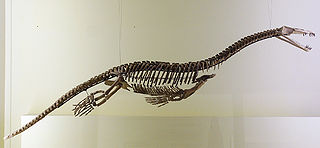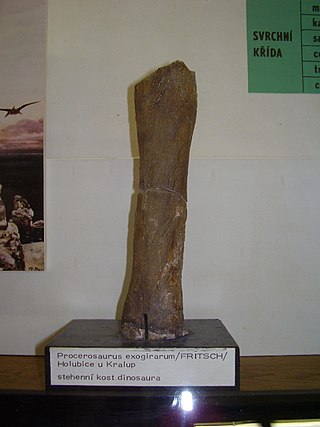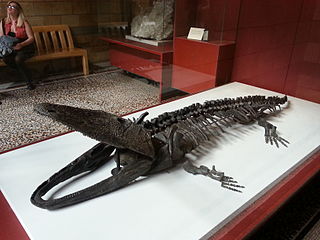
This page features lists of species and organisms that have become extinct. The reasons for extinction range from natural occurrences, such as shifts in the Earth's ecosystem or natural disasters, to human influences on nature by the overuse of natural resources, hunting and destruction of natural habitats.
Prehistoric fish are early fish that are known only from fossil records. They are the earliest known vertebrates, and include the first and extinct fish that lived through the Cambrian to the Quaternary. The study of prehistoric fish is called paleoichthyology. A few living forms, such as the coelacanth are also referred to as prehistoric fish, or even living fossils, due to their current rarity and similarity to extinct forms. Fish which have become recently extinct are not usually referred to as prehistoric fish. They were very different from what we have today. They likely were larger and had tougher scales.

Nothosaurus is an extinct genus of sauropterygian reptile from the Triassic period, approximately 240–210 million years ago, with fossils being distributed throughout the former Tethys Ocean, from North Africa and Europe to China. It is the best known member of the nothosaur order.

Ponerosteus is a dubious genus of extinct archosauromorph from the Late Cretaceous (Cenomanian-aged) Korycanar Formation of the Czech Republic that was initially identified as a species of the dinosaur Iguanodon.

Paracyclotosaurus is an extinct genus of temnospondyl, which would have appeared similar to today's salamander – but much larger, measuring up to 2.45 m (8.0 ft) long and weighing between 159 and 365 kg. It lived in the Middle Triassic period, about 235 million years ago, and fossils have been found in Australia, India, and South Africa.
Paleontology or palaeontology is the study of prehistoric life forms on Earth through the examination of plant and animal fossils. This includes the study of body fossils, tracks (ichnites), burrows, cast-off parts, fossilised feces (coprolites), palynomorphs and chemical residues. Because humans have encountered fossils for millennia, paleontology has a long history both before and after becoming formalized as a science. This article records significant discoveries and events related to paleontology that occurred or were published in the year 1970.
Nielsenia is an extinct genus of prehistoric lungfish which lived during the Devonian period in what is now Greenland. It is named after Eigil Nielsen.
Arganasaurus is an extinct genus of temnospondyls belonging to the family Metoposauridae that lived in Morocco during the Late Triassic (Carnian).
Almasaurus is an extinct genus of trematosaurian temnospondyl within the family Latiscopidae. It is known from several skulls and some postcranial material found from the Argana Formation in Morocco, which dates back to the Late Triassic.
Montcellia is an extinct genus of nectridean tetrapodomorphs within the family Urocordylidae that lived in the late Carboniferous period in the modern France.

Plagiosuchus is an extinct genus of plagiosaurid temnospondyl. It is known from several collections from the Middle Triassic of Germany.

Subcyclotosaurus is an extinct genus of carnivorous mastodonsaurid temnospondyl. It is known from a single partial skull from the Hawkesbury Sandstone formation in Australia.
Aphnelepis is an extinct genus of prehistoric freshwater ray-finned fish that lived during the Late Jurassic epoch. It contains a single species, A. australis, from the Talbragar River beds of New South Wales, Australia.

Pericentrophorus is an extinct genus of prehistoric bony fish that lived during the early Anisian age of the Middle Triassic epoch in what is now Alsace, France, and Baden-Württemberg, Germany. The type and only species is Pericentrophorus minimus.
Dorsolepis is an extinct genus of prehistoric marine ray-finned fish that lived during the early Anisian age in what is now France (Alsace) and Germany (Baden-Württemberg). Fossils were found in the Grès à Voltzia in Alsace and in the Buntsandstein in Baden-Württemberg.

Paracentrophorus is an extinct genus of prehistoric ray-finned fish that lived during the Induan age of the Early Triassic epoch in what is now Madagascar. The type species is Paracentrophorus madagascariensis (monotypy).
Ceramurus is an extinct genus of prehistoric marine ray-finned fish from the Late Jurassic. It contains a single species, C. macrocephalus from the Purbeck Group of England.

Dipteronotus is an extinct genus of marine stem-neopterygian ray-finned fish that existed during the Middle and Late Triassic epochs in what is now Europe and Morocco. As a typical feature, it had several ridge scales in front of its dorsal fin that created a spine-like structure.
Syntegmodus is an extinct genus of prehistoric bony fish. It is known from the Niobrara Formation of Kansas.
Acrodenta is an extinct genus of Late Permian captorhinid known from Marrakech-Tensift-Al Haouz of Morocco.








